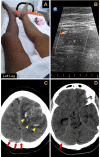Massive thrombosis and phlegmasia cerulea dolens while taking rivaroxaban: case report and review
- PMID: 34093674
- PMCID: PMC8147705
- DOI: 10.1590/1677-5449.200036
Massive thrombosis and phlegmasia cerulea dolens while taking rivaroxaban: case report and review
Abstract
Our study describes a fatal case of phlegmasia cerulea dolens and massive venous thrombosis in a patient taking rivaroxaban regularly to treat cerebral venous sinus thrombosis. Blood tests samples were positive for lupus anticoagulant. The unique evolution of the case, as well as the positivity for lupus anticoagulant, raises the possibility of an acquired hypercoagulation syndrome. We highlight the fact that the test recommended as the first line for lupus anticoagulant diagnosis (dilute Russell viper venom time) is the most affected by rivaroxaban, leading to a high prevalence of false-positive results. We also discuss potential diagnoses for the current case and review the current state-of-the-art of use of the novel oral anticoagulation agents in this unusual situation. So far, there are no recommendations to use such agents as first options in cerebral venous sinus thrombosis or in hypercoagulation syndromes.
Nosso estudo descreve um caso fatal de flegmasia cerúlea dolens e trombose venosa maciça em um paciente usando regularmente rivaroxabana para o tratamento de trombose de seio venoso cerebral. A investigação laboratorial foi positiva para o anticoagulante lúpico. A evolução única do caso aumenta a possibilidade de uma síndrome de hipercoagulabilidade adquirida, bem como a positividade para o anticoagulante lúpico. Destacamos o fato de que o teste recomendado como primeira linha para o diagnóstico de anticoagulante lúpico (veneno de víbora de Russel diluído) é o mais afetado pela rivaroxabana, levando a uma alta prevalência de resultados falso-positivos. Também discutimos os potenciais diagnósticos para o presente caso e revisamos o estado da arte atual dos novos agentes de anticoagulação oral usados nessa situação incomum. Até o presente momento, não há recomendações para o uso de tais agentes como primeira opção na trombose de seios venosos cerebrais ou nas síndromes de hipercoagulação.
Keywords: anticoagulants; sinus thrombosis, intracranial; venous thrombosis.
Copyright© 2021 The authors.
Conflict of interest statement
Conflicts of interest: No conflicts of interest declared concerning the publication of this article.
Figures

Similar articles
-
Compartment syndrome in patients with massive venous thrombosis after inferior vena cava filter placement.Orthopedics. 2011 Mar 11;34(3):229. doi: 10.3928/01477447-20110124-23. Orthopedics. 2011. PMID: 21410121
-
Phlegmasia cerulea dolens in patient with systemic lupus erythematosus in the remote postpartum period.Rev Bras Reumatol. 2011 Sep-Oct;51(5):514-6. Rev Bras Reumatol. 2011. PMID: 21953002 English, Portuguese.
-
Phlegmasia cerulea dolens as a complication of deep vein thrombosis in a man with primary antiphospholipid syndrome.Blood Coagul Fibrinolysis. 2005 Nov;16(8):567-9. doi: 10.1097/01.mbc.0000191910.24780.81. Blood Coagul Fibrinolysis. 2005. PMID: 16269930
-
Fulminant phlegmasia cerulea dolens with concurrent cholangiocarcinoma and a lupus anticoagulant: a case report and review of the literature.Blood Coagul Fibrinolysis. 2014 Jul;25(5):507-11. doi: 10.1097/MBC.0000000000000057. Blood Coagul Fibrinolysis. 2014. PMID: 24553060 Review.
-
Phlegmasia cerulea dolens following internal hemipelvectomy: Case report and literature review.Injury. 2020 Dec;51 Suppl 4:S68-S70. doi: 10.1016/j.injury.2020.02.007. Epub 2020 Feb 10. Injury. 2020. PMID: 32093946 Review.
References
Publication types
LinkOut - more resources
Full Text Sources
